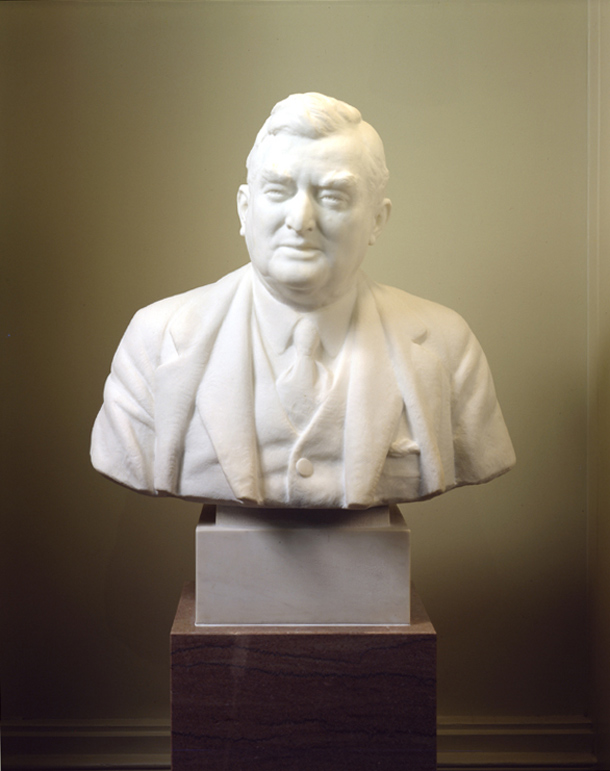
| Title | John Nance Garner |
| Artist/Maker | James Earle Fraser ( 1876 - 1953 ) |
| Date | 1943 |
| Medium | Marble |
| Dimensions | h. 34 x w. 28 x d. 16.5 in. (h. 86.4 x w. 71.1 x d. 41.9 cm) |
| Credit Line | U.S. Senate Collection |
| Accession Number | 22.00032.000 |
James Earle Fraser, one of the most highly respected American sculptors of the early 20th century, studied at the Art Institute of Chicago and the École des Béaux-Arts in Paris. He became an apprentice and assistant to the renowned Augustus Saint-Gaudens, initially in Paris and later in Cornish, New Hampshire. Fraser subsequently established a studio in New York City, where he began a prolific career creating medallion reliefs, allegorical sculpture, and statues of prominent Americans. One of the artist’s earliest and best-known works, The End of the Trail, depicts an exhausted Native American warrior on his mount. Other major pieces include sculptures of Thomas Jefferson, Alexander Hamilton, and Benjamin Franklin, as well as reliefs for the American “Buffalo” nickel-a bison on one side and a Native American profile on the other. In the U.S. Capitol, Fraser’s busts of Theodore Roosevelt and John Nance Garner are in the Senate’s Vice Presidential Bust Collection, and three plaster reliefs by his sculptor-wife, Laura Gardin Fraser, are located in the House Chamber.
More than 25 years after he sculpted Theodore Roosevelt for the Vice Presidential Bust Collection, Fraser was selected to execute a bust of Vice President John Nance Garner. The vice president sat for Fraser during 1937 and 1938. Fraser was selected for the commission because he usually worked quickly and required few sittings, but it was 1943 before the artist finally submitted his work for Senate approval. Fraser initially executed two preparatory plaster busts for consideration. According to the artist, the vice president liked “the quiet one,” while Fraser and his artist friends preferred the second version. Fraser wrote to Architect of the Capitol David Lynn: “I believe you also liked the one I like. Is there any reason why I should not take the one I prefer?” While Lynn’s decision is unknown, a choice was made between these two versions in 1941, and Fraser signed a contract for $1,000 to supply the finished marble. More than two years passed before the completed bust arrived at the Capitol. The sculptor blamed the delay on the press of other work and on the difficulty of locating superior marble cutters during war time. Among other projects then claiming his attention were two mammoth outdoor groups commissioned for the entrance to Rock Creek Parkway near Memorial Bridge in Washington, D.C.
John Nance Garner, a U.S. representative and 32nd vice president of the United States, was born in Red River County, Texas. He served in the Texas state legislature and in 1902 was elected as a Democrat to the U.S. House of Representatives, where he distinguished himself as an expert parliamentarian. Known as "Cactus Jack," the plainspoken and unpretentious Garner displayed simple tastes and a pragmatic style. He was elected minority leader in 1929 and became Speaker two years later when his party won control of the House.
At the Democratic National Convention in 1932, Garner was a leading candidate for the presidential nomination until he was persuaded to withdraw in favor of Franklin Roosevelt. To avoid deadlock at the convention, Garner accepted the vice presidential nomination, albeit reluctantly. Although he later expressed dissatisfaction with the vice presidency, describing it as "the spare tire on the automobile of government" [1] and "not worth a bucket of warm spit," [2] Garner's political acumen proved highly valuable in his role as president of the Senate. Garner served two terms and was considered one of the most influential 20th-century vice presidents. Having broken with Roosevelt in 1937 over the president's controversial attempts to pack the Supreme Court with New Deal sympathizers, Garner did not join Roosevelt when he ran for an unprecedented third term in 1940. Instead, the vice president retired to Texas, where he enjoyed the role of political pundit until his death in 1967.
1. Jules Whitcover, Crapshoot: Rolling the Dice on the Vice Presidency: From Adams and Jefferson to Truman and Quayle (New York: Crown, 1992), 400.
2. Bascom Nolly Timmons, Garner of Texas: A Personal History (New York: Harper, 1948), 176.